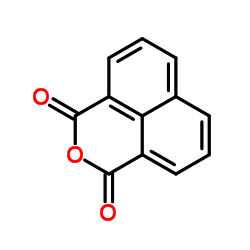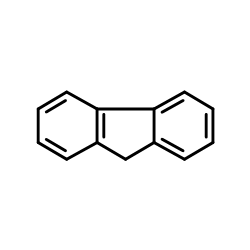Acenaphthylene

Acenaphthylene structure
|
Common Name | Acenaphthylene | ||
|---|---|---|---|---|
| CAS Number | 208-96-8 | Molecular Weight | 152.192 | |
| Density | 1.2±0.1 g/cm3 | Boiling Point | 298.9±7.0 °C at 760 mmHg | |
| Molecular Formula | C12H8 | Melting Point | 78-82 °C(lit.) | |
| MSDS | Chinese USA | Flash Point | 137.2±8.9 °C | |
| Symbol |

GHS07 |
Signal Word | Warning | |
Use of AcenaphthyleneAcenaphthylene is a polycyclic aromatic hydrocarbon (PAH). PAHs are derived naturally from coal and tar deposits, and produced by incomplete combustion of organic matter[1]. |
| Name | Acenaphthalene |
|---|---|
| Synonym | More Synonyms |
| Description | Acenaphthylene is a polycyclic aromatic hydrocarbon (PAH). PAHs are derived naturally from coal and tar deposits, and produced by incomplete combustion of organic matter[1]. |
|---|---|
| Related Catalog | |
| References |
| Density | 1.2±0.1 g/cm3 |
|---|---|
| Boiling Point | 298.9±7.0 °C at 760 mmHg |
| Melting Point | 78-82 °C(lit.) |
| Molecular Formula | C12H8 |
| Molecular Weight | 152.192 |
| Flash Point | 137.2±8.9 °C |
| Exact Mass | 152.062607 |
| LogP | 4.26 |
| Vapour Pressure | 0.0±0.3 mmHg at 25°C |
| Index of Refraction | 1.732 |
| Stability | Stable. Incompatible with oxidizing agents. |
CHEMICAL IDENTIFICATION
HEALTH HAZARD DATAACUTE TOXICITY DATA
MUTATION DATA
|
| Symbol |

GHS07 |
|---|---|
| Signal Word | Warning |
| Hazard Statements | H302-H315-H319-H335 |
| Precautionary Statements | P280-P301 + P312 + P330-P305 + P351 + P338-P337 + P313 |
| Personal Protective Equipment | dust mask type N95 (US);Eyeshields;Gloves |
| Hazard Codes | Xi:Irritant; |
| Risk Phrases | R36/37/38 |
| Safety Phrases | S26-S36/37/39-S62-S61-S60-S45-S36/37-S16-S7 |
| RIDADR | UN 1145 3/PG 2 |
| WGK Germany | 3 |
| RTECS | AB1254000 |
| HS Code | 2902909090 |
| Precursor 10 | |
|---|---|
| DownStream 9 | |
| HS Code | 2902909090 |
|---|---|
| Summary | 2902909090 other aromatic hydrocarbons。Supervision conditions:None。VAT:17.0%。Tax rebate rate:9.0%。MFN tariff:2.0%。General tariff:30.0% |
|
Cumulative health risk assessment of halogenated and parent polycyclic aromatic hydrocarbons associated with particulate matters in urban air.
Ecotoxicol. Environ. Saf. 113 , 31-7, (2015) Halogenated polycyclic aromatic hydrocarbons (HPAHs) have been reported to occur widely in urban air. Nevertheless, knowledge about the human health risk associated with inhalation exposure to HPAHs i... |
|
|
Levels of polycyclic aromatic hydrocarbons in maternal serum and risk of neural tube defects in offspring.
Environ. Sci. Technol. 49(1) , 588-96, (2015) Polycyclic aromatic hydrocarbons (PAHs) are ubiquitous environmental pollutants, and have been reported to be a risk factor for human neural tube defects (NTDs). We investigated the relationship betwe... |
|
|
Pollution biomonitoring in the Bizerte lagoon (Tunisia), using combined chemical and biomarker analyses in grass goby, Zosterisessor ophiocephalus (Teleostei, Gobiidae).
Mar. Environ. Res. 101 , 184-95, (2014) In this study, biological responses and contaminant levels in biological tissues were investigated in grass goby fish specimens (Zosterisessor ophiocephalus) collected from five stations in a moderate... |
| acenaphthene |
| MFCD00003806 |
| EINECS 205-917-1 |
| 1,8-ethylene-naphthalene |
| Acenaphthylene |
| Cyclopenta(de)naphthalene |
 CAS#:6306-07-6
CAS#:6306-07-6 CAS#:164665-41-2
CAS#:164665-41-2 CAS#:83-32-9
CAS#:83-32-9![1H,3H-Naphtho[1,8-cd]thiopyran 2,2-Dioxide Structure](https://image.chemsrc.com/caspic/470/29376-61-2.png) CAS#:29376-61-2
CAS#:29376-61-2 CAS#:14966-36-0
CAS#:14966-36-0 CAS#:14209-08-6
CAS#:14209-08-6 CAS#:182313-38-8
CAS#:182313-38-8 CAS#:118-75-2
CAS#:118-75-2 CAS#:82-86-0
CAS#:82-86-0 CAS#:2026-08-6
CAS#:2026-08-6![Ethyl 7,7a-dihydro-6bH-cyclopropa[a]acenaphthylene-7-carboxylate structure](https://image.chemsrc.com/caspic/327/109475-21-0.png) CAS#:109475-21-0
CAS#:109475-21-0 CAS#:20485-57-8
CAS#:20485-57-8 CAS#:21857-35-2
CAS#:21857-35-2 CAS#:40745-41-3
CAS#:40745-41-3 CAS#:81-84-5
CAS#:81-84-5![1H,3H-Naphtho[1,8-cd]pyran-1-one,3-hydroxy- structure](https://image.chemsrc.com/caspic/151/5656-90-6.png) CAS#:5656-90-6
CAS#:5656-90-6![3-methoxy-1H,3H-naphtho[1,8-cd]pyran-1-one structure](https://image.chemsrc.com/caspic/073/31553-19-2.png) CAS#:31553-19-2
CAS#:31553-19-2 CAS#:86-73-7
CAS#:86-73-7
